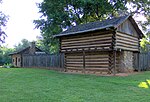Sabine Hill

Sabine Hill, also known as Happy Valley, Watauga Point, and the General Nathaniel Taylor House, is a historic house in Elizabethton, Tennessee. The two-story Federal style building was listed on the National Register of Historic Places in 1973. It is an excellent example of federal architecture. It was threatened by demolition in 2007 when the owners sought to have the property rezoned for apartments. The rezoning request was denied and the home was bought by several preservation-minded locals who secured it until the State of Tennessee/Tennessee Historical Commission could purchase the museum-quality property. It is now restored and opened to the public on November 1, 2017, as a unit of Sycamore Shoals State Park. The property is operated by the Park under a memorandum of understanding with the Tennessee Historical Commission.
Excerpt from the Wikipedia article Sabine Hill (License: CC BY-SA 3.0, Authors, Images).Sabine Hill
Buck Van Huss Road,
Geographical coordinates (GPS) Address Nearby Places Show on map
Geographical coordinates (GPS)
| Latitude | Longitude |
|---|---|
| N 36.325833333333 ° | E -82.269722222222 ° |
Address
Elizabethton Municipal Golf Course
Buck Van Huss Road 185
37643
Tennessee, United States
Open on Google Maps





